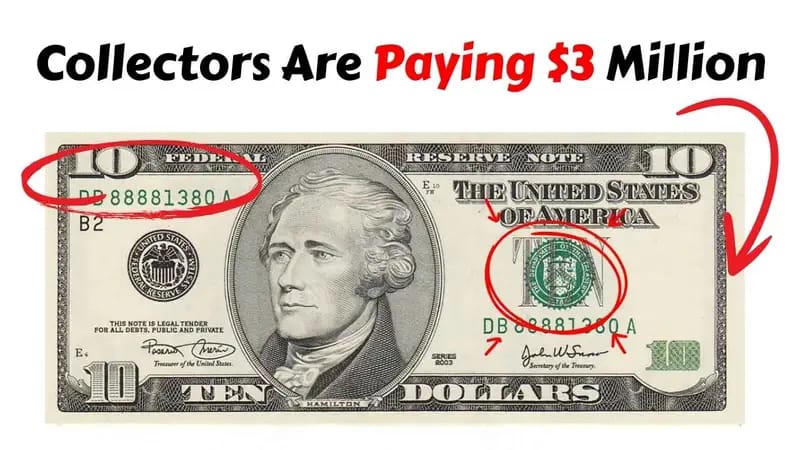We’ve all dreamed of it: finding a forgotten treasure in the attic or a hidden gem tucked inside an old book. For one lucky family in California, that daydream became a stunning reality. While sorting through a box of their late grandfather’s belongings, they discovered a simple $10 bill. It looked old, but nothing out of the ordinary—until they learned it was just auctioned for a life-changing $3 million.
What Makes This $10 Bill So Incredibly Valuable?
This isn’t the same worn tenner you get as change from the coffee shop. The bill that sold for millions is a specific and legendary piece of American financial history: a 1933 $10 Legal Tender Note, often called a “Gold Certificate” due to its distinctive gold hue and the phrase “Will Pay To The Bearer On Demand” it features.
Its astronomical value comes from a perfect storm of three key factors:
- Extreme Rarity: The U.S. abandoned the gold standard in 1933, the very year this bill was printed. This led to most of these notes being withdrawn from circulation and destroyed by the government. It’s believed that fewer than a dozen are known to exist today, and the vast majority are already in museums or ultra-secure private collections.
- Pristine Condition: Currency is meant to be used, so most old bills are worn, torn, and faded. This particular note was preserved with incredible care, likely stored away the moment it was printed. Professional grading services awarded it an exceptional grade, signifying it’s in near-perfect condition for its age.
- Historical Significance: It’s a tangible artifact from a pivotal moment in U.S. history, representing the end of an era in American banking and finance. For collectors, owning it is like owning a museum-piece.
The Story Behind the Discovery
The find wasn’t just a fluke; it was a piece of family history. The bill belonged to the family’s grandfather, a World War II veteran who had a passion for collecting coins and unusual currency. For decades, it sat quietly in a small wooden box with other keepsakes, passed down but never truly appraised. Its crisp condition showed it had been a cherished item, protected from the wear and tear of everyday life.
It was only when a family member, curious about the old money, decided to do some research that they realized they might be sitting on a potential goldmine.
From a Family Heirloom to a Million-Dollar Payday
The family’s next step was crucial. They took the bill to a reputable currency dealer for formal authentication. Experts confirmed it was the real deal—an authentic 1933 $10 Legal Tender Note in spectacular condition.
When it hit the auction block, the response was electric. Collectors and investors from around the globe engaged in a fierce bidding war, rapidly driving the price into the millions. The gavel finally fell at $3 million, sold to an anonymous bidder.
For the family, the windfall is more than just a number. They’ve stated plans to pay off debts, secure educational futures with college funds, and set aside a portion as a lasting legacy, honoring their grandfather’s unintentionally brilliant investment.
How to Identify Valuable Currency
While finding a multi-million dollar bill is a long shot, valuable currency is out there. It pays to know what to look for. Here’s a quick guide to some key features that can add value:
Feature What to Look For Why It’s Valuable
Low Serial Number Numbers like 00000001 or 00000010 Highly sought after by collectors.
Star Note A star (*) at the end of the serial number Printed to replace misprinted bills, making them rarer.
Misprints Off-center printing, mismatched faces, ink smears Errors make a bill unique and desirable.
Old Series Date Pre-1934 notes (especially from the 1920s & earlier) Age and historical context can increase value.
Exceptional Condition Crisp paper, sharp corners, no folds or stains A bill in “Uncirculated” condition is always worth more.
Frequently Asked Questions (FAQs)
- How can I get my old bills appraised? Start by researching online using the features in the table above.For a formal valuation, seek out a reputable coin and currency dealer or a professional grading service like PCGS or PMG. Avoid pawn shops for high-value items.
- Are all old bills valuable? No,not necessarily. Age alone doesn’t guarantee value. A worn, common bill from 1930 might only be worth its face value. Value is determined by rarity, condition, and demand among collectors.
- What should I do if I think I have a valuable bill? Handle it as little as possible and always hold it by the edges to preserve its condition.Store it in a protective sleeve (available at hobby shops) and then consult an expert for authentication.
- Where is the best place to look for valuable money? Check old piggy banks,albums, books, and boxes of inherited keepsakes. Many people also search through circulated currency by getting rolls of coins from the bank or examining every bill they receive as change.
- Did the family have to pay taxes on the $3 million? Yes,such a windfall is typically considered taxable income. It’s wise for anyone in this situation to consult with a financial advisor or tax professional to understand the implications.
The next time you’re cleaning out a drawer or going through an old collection, take a moment to look a little closer. You might not find $3 million, but you could easily uncover a piece of history worth hundreds or even thousands. Happy hunting
